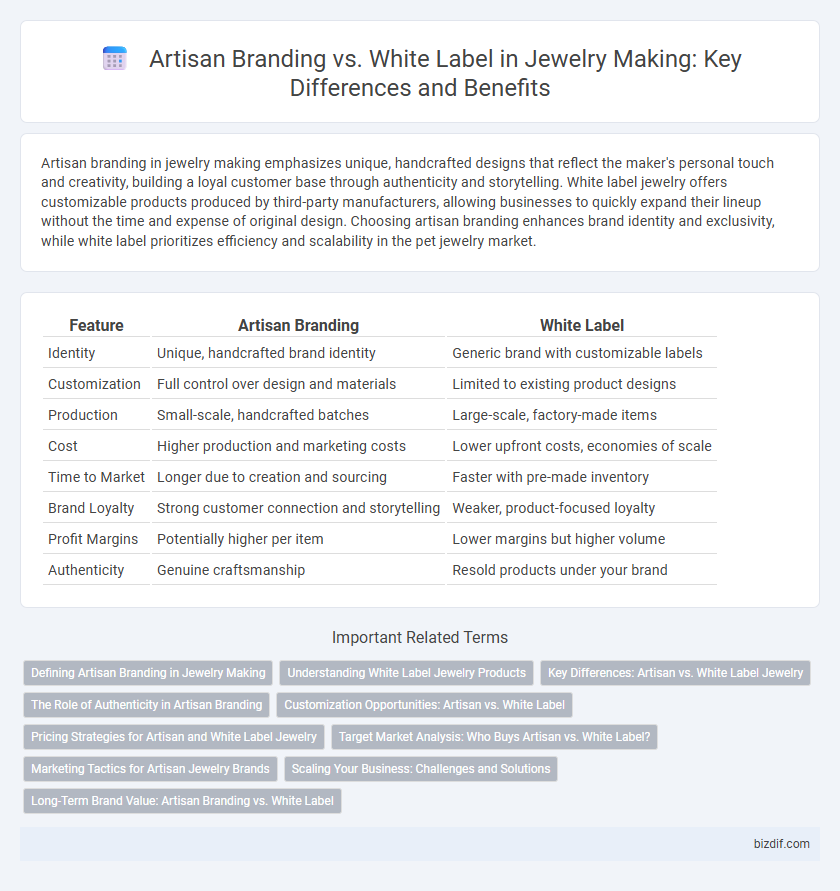Artisan branding in jewelry making emphasizes unique, handcrafted designs that reflect the maker's personal touch and creativity, building a loyal customer base through authenticity and storytelling. White label jewelry offers customizable products produced by third-party manufacturers, allowing businesses to quickly expand their lineup without the time and expense of original design. Choosing artisan branding enhances brand identity and exclusivity, while white label prioritizes efficiency and scalability in the pet jewelry market.
Table of Comparison
| Feature | Artisan Branding | White Label |
|---|---|---|
| Identity | Unique, handcrafted brand identity | Generic brand with customizable labels |
| Customization | Full control over design and materials | Limited to existing product designs |
| Production | Small-scale, handcrafted batches | Large-scale, factory-made items |
| Cost | Higher production and marketing costs | Lower upfront costs, economies of scale |
| Time to Market | Longer due to creation and sourcing | Faster with pre-made inventory |
| Brand Loyalty | Strong customer connection and storytelling | Weaker, product-focused loyalty |
| Profit Margins | Potentially higher per item | Lower margins but higher volume |
| Authenticity | Genuine craftsmanship | Resold products under your brand |
Defining Artisan Branding in Jewelry Making
Artisan branding in jewelry making emphasizes unique, handcrafted pieces that showcase the maker's personal style and craftsmanship, creating a distinct identity in the market. This approach highlights authenticity, storytelling, and quality materials, fostering a deeper connection between the artisan and the customer. Unlike white label products, artisan branding builds long-term brand equity through originality and exclusivity.
Understanding White Label Jewelry Products
White label jewelry products allow artisans and retailers to offer customizable designs without investing in the full production process, enabling rapid market entry and brand consistency. These products often feature generic base components that can be personalized with logos, packaging, or surface finishes to align with the seller's brand identity. Understanding white label sourcing benefits includes reduced manufacturing costs, streamlined supply chains, and the ability to scale collections quickly while maintaining quality standards.
Key Differences: Artisan vs. White Label Jewelry
Artisan jewelry showcases unique, handcrafted designs reflecting the maker's personal creativity and craftsmanship, often involving limited production runs and high customization. White label jewelry involves mass-produced pieces created by manufacturers, allowing retailers to market the products under their own brand without design ownership. Key differences include authenticity, with artisan pieces offering exclusive artistry, while white label jewelry prioritizes scalability and brand flexibility.
The Role of Authenticity in Artisan Branding
Artisan branding in jewelry making emphasizes authenticity by highlighting the unique craftsmanship, cultural heritage, and personal stories behind each piece, creating a deeper emotional connection with customers. This genuine narrative differentiates artisan brands from white label products, which often lack individuality and mass-produce similar designs without a distinct origin. Authentic branding enhances perceived value and fosters customer loyalty by celebrating the skill and dedication of the artisan.
Customization Opportunities: Artisan vs. White Label
Artisan branding offers extensive customization opportunities, allowing jewelers to design unique pieces that reflect their personal style and craftsmanship. White label products typically provide limited customization, focusing on pre-designed templates with minimal alterations. This distinction empowers artisans to create exclusive collections, while white label focuses on scalability and ease of market entry.
Pricing Strategies for Artisan and White Label Jewelry
Artisan jewelry pricing strategies emphasize handcrafted uniqueness, often incorporating premium costs for materials and labor to reflect exclusivity and craftsmanship. White label jewelry pricing typically relies on competitive, market-driven rates due to bulk production and lower per-unit costs, focusing on volume sales and brand versatility. Understanding customer perception and market positioning is crucial for both approaches to maximize profitability and brand value.
Target Market Analysis: Who Buys Artisan vs. White Label?
Artisan jewelry appeals primarily to consumers seeking unique, handcrafted pieces that reflect personal stories and local craftsmanship, often attracting niche markets valuing authenticity and exclusivity. White label jewelry targets broader audiences, including retailers and businesses aiming for cost-effective, customizable products with faster turnaround and scalability. Understanding these distinct consumer preferences enables brands to tailor marketing strategies and product development to effectively capture each segment's demand.
Marketing Tactics for Artisan Jewelry Brands
Artisan jewelry brands build distinct identities through storytelling, emphasizing craftsmanship and unique design to connect emotionally with niche audiences. Marketing tactics leverage social media engagement and influencer partnerships that highlight the creator's authenticity, contrasting with white label products, which rely heavily on price competitiveness and broad distribution channels. Prioritizing handcrafted narratives and personalized customer experiences enhances brand loyalty and stands out in the saturated artisan jewelry market.
Scaling Your Business: Challenges and Solutions
Artisan branding in jewelry making allows for unique identity and creative control, but scaling poses challenges like limited production capacity and higher costs. White label solutions enable rapid business growth with ready-made designs and streamlined manufacturing, yet risk diluting brand distinctiveness. Strategic partnerships and leveraging digital marketing can balance these models, facilitating scalable growth while maintaining customer loyalty.
Long-Term Brand Value: Artisan Branding vs. White Label
Artisan branding in jewelry making cultivates long-term brand value through unique craftsmanship and authentic storytelling, fostering customer loyalty and market differentiation. White label products prioritize immediate scalability but often lack distinctiveness, limiting brand recognition and sustainable growth. Invested artisan branding generates enduring equity by emphasizing originality and emotional connection with consumers.
Artisan branding vs white label Infographic

 bizdif.com
bizdif.com